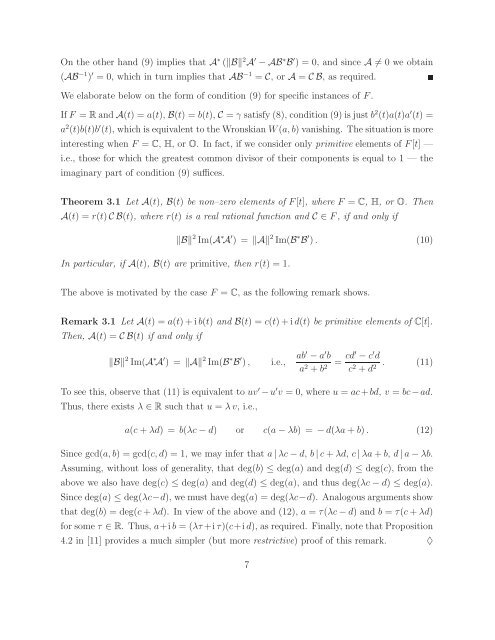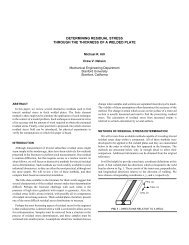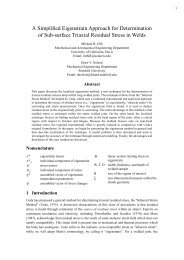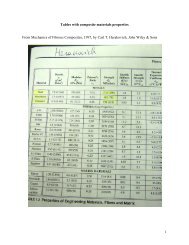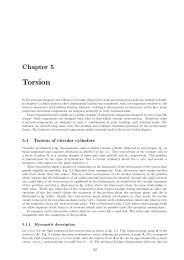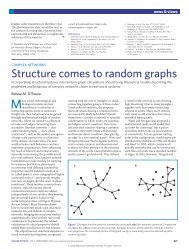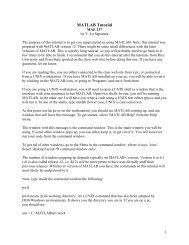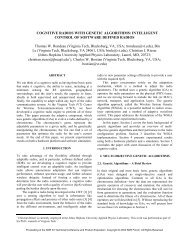Pythagorean-hodograph curves in Euclidean spaces of dimension ...
Pythagorean-hodograph curves in Euclidean spaces of dimension ...
Pythagorean-hodograph curves in Euclidean spaces of dimension ...
Create successful ePaper yourself
Turn your PDF publications into a flip-book with our unique Google optimized e-Paper software.
On the other hand (9) implies that A ∗ (B 2 A ′ − AB ∗ B ′ ) = 0, and s<strong>in</strong>ce A = 0 we obta<strong>in</strong><br />
(AB −1 ) ′ = 0, which <strong>in</strong> turn implies that AB −1 = C, or A = C B, as required.<br />
We elaborate below on the form <strong>of</strong> condition (9) for specific <strong>in</strong>stances <strong>of</strong> F.<br />
If F = R and A(t) = a(t), B(t) = b(t), C = γ satisfy (8), condition (9) is just b 2 (t)a(t)a ′ (t) =<br />
a 2 (t)b(t)b ′ (t), which is equivalent to the Wronskian W(a, b) vanish<strong>in</strong>g. The situation is more<br />
<strong>in</strong>terest<strong>in</strong>g when F = C, H, or O. In fact, if we consider only primitive elements <strong>of</strong> F[t] —<br />
i.e., those for which the greatest common divisor <strong>of</strong> their components is equal to 1 — the<br />
imag<strong>in</strong>ary part <strong>of</strong> condition (9) suffices.<br />
Theorem 3.1 Let A(t), B(t) be non–zero elements <strong>of</strong> F[t], where F = C, H, or O. Then<br />
A(t) = r(t) C B(t), where r(t) is a real rational function and C ∈ F, if and only if<br />
In particular, if A(t), B(t) are primitive, then r(t) = 1.<br />
B 2 Im(A ∗ A ′ ) = A 2 Im(B ∗ B ′ ) . (10)<br />
The above is motivated by the case F = C, as the follow<strong>in</strong>g remark shows.<br />
Remark 3.1 Let A(t) = a(t) +ib(t) and B(t) = c(t) + i d(t) be primitive elements <strong>of</strong> C[t].<br />
Then, A(t) = C B(t) if and only if<br />
B 2 Im(A ∗ A ′ ) = A 2 Im(B ∗ B ′ ) , i.e.,<br />
ab ′ − a ′ b<br />
a2 + b2 = cd′ − c ′ d<br />
c2 . (11)<br />
+ d2 To see this, observe that (11) is equivalent to uv ′ −u ′ v = 0, where u = ac+bd, v = bc −ad.<br />
Thus, there exists λ ∈ R such that u = λ v, i.e.,<br />
a(c + λd) = b(λc − d) or c(a − λb) = −d(λa + b) . (12)<br />
S<strong>in</strong>ce gcd(a, b) = gcd(c, d) = 1, we may <strong>in</strong>fer that a | λc − d, b | c + λd, c | λa + b, d | a − λb.<br />
Assum<strong>in</strong>g, without loss <strong>of</strong> generality, that deg(b) ≤ deg(a) and deg(d) ≤ deg(c), from the<br />
above we also have deg(c) ≤ deg(a) and deg(d) ≤ deg(a), and thus deg(λc − d) ≤ deg(a).<br />
S<strong>in</strong>ce deg(a) ≤ deg(λc−d), we must have deg(a) = deg(λc−d). Analogous arguments show<br />
that deg(b) = deg(c + λd). In view <strong>of</strong> the above and (12), a = τ(λc − d) and b = τ(c + λd)<br />
for some τ ∈ R. Thus, a+i b = (λτ +i τ)(c+i d), as required. F<strong>in</strong>ally, note that Proposition<br />
4.2 <strong>in</strong> [11] provides a much simpler (but more restrictive) pro<strong>of</strong> <strong>of</strong> this remark. ♦<br />
7


